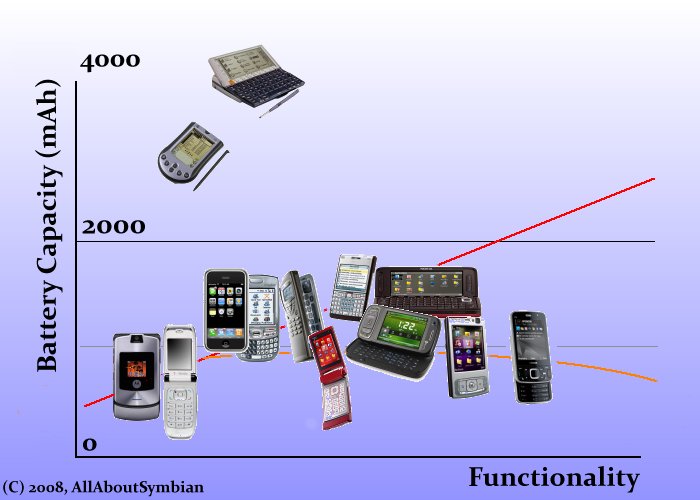A few weeks ago, I proposed that there was a battery threshold, beneath which one was miserable and above which one was happy. I even went as far as to name models that were above and below this virtual line. We've now had the announcement of (for example) the Nokia N96, with a 950mAh battery. How will this fare and how does it compare to devices of today and yesteryear?

As usual with these pretty charts, there's only room for a handful of thumbnails, but I still hope to make a point. Right at the top, we see the past - glorious battery life (weeks) but at the expense of lacklustre screens, dependence on replaceable AA or AAA cells and little or no wireless/phone functionality. Although it would be cool to speculate on the life of (say) a modern Nokia Nseries device powered by two AAA cells totalling 3000mAh between them, i.e. three times the current capacity of many internal rechargeable Li-Ion cells, it would be fairly pointless since the market seems to have categorically turned away from disposable batteries towards internal rechargeables, for both lower impact on the environment and also greater convenience. The days of AA and AAA-powered handhelds are long gone, I suspect.
So, turning to the modern era, note the dark red line above, representing an approximation of where devices need to lie in order to stay on or above my aforementioned 'threshold' and to keep their owners happy. The line rises because, obviously, the less functionality a portable device has, the lower its power needs and the less it will be used, meaning that the manufacturer can get away with a smaller capacity battery.
At the high end, with goodies like high megapixel still and video cameras, Wi-Fi, GPS, DVB-H receivers and so on, the extra power drain is significant, plus there's the on-more-often factor, as users naturally start using the features they've paid for. If anything, the dark red line should curve up slightly, but I've been generous and have kept it straight. The orange line reflects roughly the current trend, showing that battery life is becoming more and more an issue with today's 'do it all' smartphones.
As wonderful as many of Nokia's Nseries are, for example, and even allowing for software and hardware optimisations in recent chipsets and firmwares, you can't (to quote Star Trek) change the laws of physics - energy is energy and when it's all gone then it's all gone. It takes a finite amount of current to power a 2.8" colour screen with backlight, it takes a finite current to power up a camera or GPS or Wi-Fi radio, etc. and at the end of the day I'd much rather have a definite larger battery with oomph in hand than a set of optimisations that make only a slight difference.
In terms of modern Symbian OS devices, the Nokia Eseries communicators are close to the red line and are generally amply equipped for their purpose. The Sony Ericsson UIQ 3 smartphones, not shown above but lying somewhere close to the HTC Tilt pictured, are slightly underpowered but usably so. The culprits here, as noted by many a commentator over the last few years, are Nokia's Nseries 'multimedia computers'.
Now, don't get me wrong, I love my N93 and N95 'classic' to bits and find them incredibly useful. But when using either of them as my main smartphone, battery (1100mAh and 950mAh respectively) was always an issue and I'd be in trouble trying to get through a single day of use and became used to carrying around a Proporta charger in a spare pocket. The release of the N95 8GB (with 1200mAh battery) helped somewhat and solved the matter of getting through the day, albeit often without much to spare.

But, with this week's launch of the N96, with 950mAh battery, and even the release of the N82, with 1050mAh battery, I have to observe that Nokia's Nseries team really hasn't learned their lesson here - both devices struggle when used to their potential, for want of a larger battery. The Eseries designs approach build materials and battery life from a 'never mind the weight, check out durability and battery capacity' standpoint and this resonates with me. Whether my smartphone weighs 110g or 130g is pretty irrelevant, surely, compared to the average person's body weight and arm strength, yet those extra 20g could allow the inclusion of a battery with 50% more capacity.
In my opinion that's a tradeoff well worth going for. Smartphone designers everywhere - try and keep your creations on the red line, please!
Steve Litchfield, All About Symbian, 13 Feb 2008
